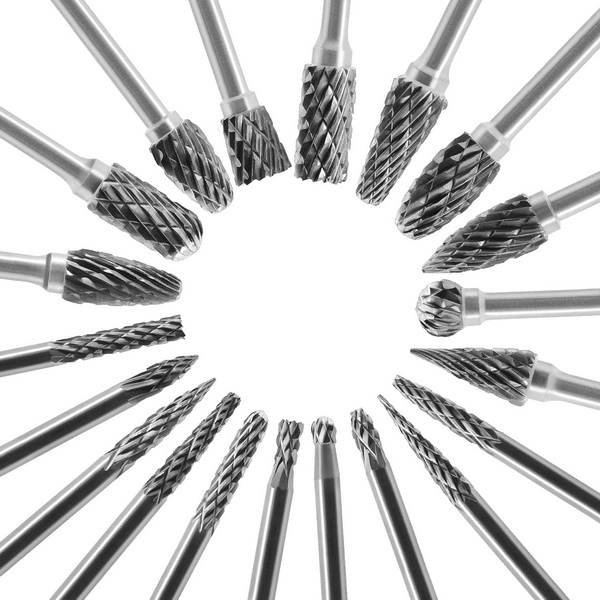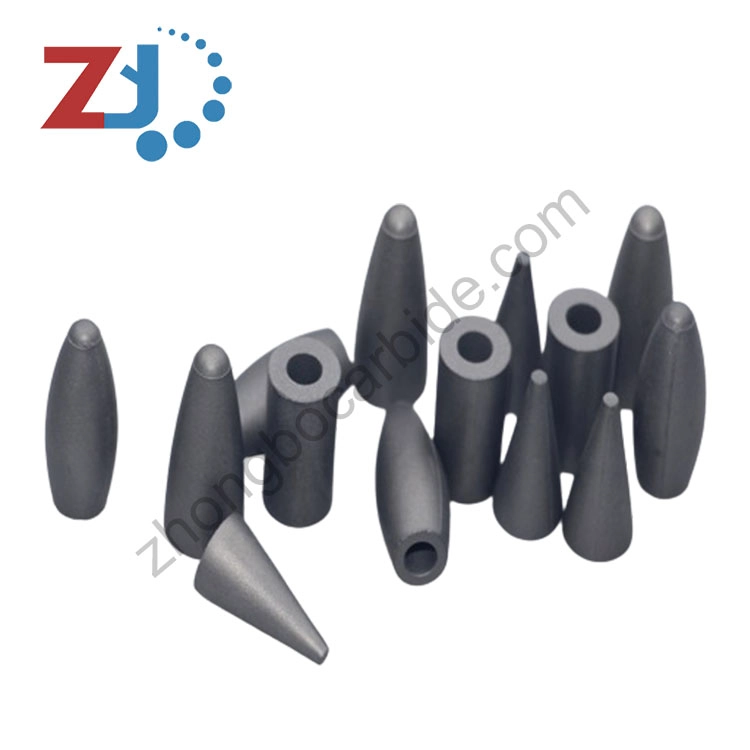Content Menu
● What Are Tungsten Carbide Burrs?
>> Composition and Manufacturing
● Can Tungsten Carbide Burrs Be Used on Metal?
● Applications of Tungsten Carbide Burrs in Metalworking
● Benefits of Using Tungsten Carbide Burrs on Metal
● Types of Tungsten Carbide Burrs
● Proper Usage of Tungsten Carbide Burrs
● Maintenance of Tungsten Carbide Burrs
● Best Practices When Using Tungsten Carbide Burrs
● Safety Considerations
● Conclusion
● FAQs
>> 1. What materials can tungsten carbide burrs be used on?
>> 2. How do I choose the right tungsten carbide burr?
>> 3. Can tungsten carbide burrs be sharpened?
>> 4. What safety precautions should I take when using tungsten carbide burrs?
>> 5. How long do tungsten carbide burrs last?
● Citations:
Tungsten carbide burrs are specialized rotary cutting tools made from a hard compound of tungsten and carbon. They are widely recognized for their durability and versatility, making them essential in various industries, including metalworking, woodworking, and automotive repair. This article explores whether tungsten carbide burrs can be used on metal, their applications, benefits, and best practices for use.

What Are Tungsten Carbide Burrs?
Tungsten carbide burrs are small, rotating tools that are used for shaping, grinding, and deburring materials. Their composition gives them exceptional hardness, allowing them to cut through tough materials like metals effectively. The burrs come in various shapes and sizes, each designed for specific tasks.
Composition and Manufacturing
The manufacturing process of tungsten carbide burrs involves mixing tungsten carbide powder with a binder material (often cobalt), which is then pressed into shape and sintered to create a solid tool. This process ensures that the burrs are not only hard but also resistant to wear and heat. The high density of tungsten carbide contributes to its ability to withstand extreme conditions, making it suitable for demanding applications.
Can Tungsten Carbide Burrs Be Used on Metal?
Yes, tungsten carbide burrs can be used on metal. They are particularly effective for shaping and finishing ferrous and non-ferrous metals such as:
- Steel: Both soft and hardened steel can be shaped and deburred using carbide burrs.
- Aluminum: The burrs work well with aluminum, providing smooth finishes.
- Cast Iron: Tungsten carbide burrs can efficiently remove excess material from cast iron surfaces.
- Copper: They are also suitable for working with copper due to their hardness.
The ability of tungsten carbide burrs to withstand high temperatures without losing their hardness makes them ideal for metalworking applications where heat generation is common.
Applications of Tungsten Carbide Burrs in Metalworking
Tungsten carbide burrs have a wide range of applications in metalworking:
1. Deburring: Removing sharp edges and imperfections from metal surfaces.
2. Shaping: Creating specific shapes or contours in metal components.
3. Finishing: Providing a smooth surface finish on machined parts.
4. Welding Preparation: Cleaning up weld seams for better aesthetics and functionality.
5. Surface Cleaning: Removing rust or oxidation from metal surfaces.
6. Engraving: Creating detailed designs or markings on metal surfaces.
7. Grooving: Cutting grooves into metal for various applications, including fitting parts together.

Benefits of Using Tungsten Carbide Burrs on Metal
The advantages of using tungsten carbide burrs for metalworking include:
- Durability: Tungsten carbide is significantly harder than steel, allowing the burrs to maintain their cutting edge longer.
- Heat Resistance: They can operate at higher temperatures without losing effectiveness.
- Versatility: Suitable for various materials beyond metal, including wood and plastics.
- Efficiency: High stock removal rates reduce the time required for tasks.
- Precision: Tungsten carbide burrs provide excellent control over the cutting process, allowing for intricate work without damaging the surrounding material.
Types of Tungsten Carbide Burrs
Different types of tungsten carbide burrs are designed for specific tasks:
| Type |
Shape |
Common Uses |
| Ball Nose |
Round |
Ideal for hole deburring and carving |
| Cylinder |
Straight-sided |
Used for flat surfaces and edges |
| Flame Shape |
Tapered |
Excellent for contouring and shaping |
| Cone Shape |
Conical |
Useful for internal surfaces |
| Tree Shape |
Tree-like |
Great for detailed work and engraving |
| Pointed Cone |
Sharp tip |
Effective for creating fine details |
| Radius End |
Rounded end |
Best for smoothing edges without sharp corners |
Proper Usage of Tungsten Carbide Burrs
To maximize the effectiveness of tungsten carbide burrs when working with metal, consider the following tips:
- Choose the Right Burr Shape: Select a shape that suits your specific task. For example, use a ball nose burr for internal work or a cylindrical one for flat surfaces.
- Use Appropriate Speed Settings: Operate at recommended speeds based on the material being worked on. Generally, higher speeds are effective on softer metals like aluminum while slower speeds may be needed for harder materials like steel.
- Maintain Consistent Pressure: Apply even pressure to avoid damaging the burr or the workpiece. Too much pressure can lead to premature wear or breakage of the tool.
- Wear Protective Gear: Always wear safety goggles and gloves to protect against flying debris. Additionally, consider using ear protection if operating at high speeds due to noise levels.
Maintenance of Tungsten Carbide Burrs
Proper maintenance extends the life of your tungsten carbide burrs:
- Cleaning: Regularly clean the burr after use to remove debris. Use a brush or compressed air to clear out any material lodged in the flutes.
- Storage: Store in a dry place to prevent damage or corrosion. Consider using protective cases or racks specifically designed for tool storage.
- Inspection: Regularly check for wear or damage before use. Look for signs of chipping or dullness which may indicate that it's time to replace the burr.
Best Practices When Using Tungsten Carbide Burrs
In addition to proper usage techniques, following best practices can enhance your experience with tungsten carbide burrs:
1. Test on Scrap Material First: Before working on your actual project, test the burr on scrap material to ensure you achieve the desired results without damaging your primary workpiece.
2. Keep Your Work Area Clean: A clean workspace minimizes distractions and helps prevent accidents caused by clutter or debris.
3. Adjust Your Technique Based on Material Type: Different metals may require adjustments in technique; softer metals may need faster speeds while harder metals may require slower speeds with more pressure.
4. Use Lubrication When Necessary: For particularly tough materials or when working at high speeds, consider using lubrication (such as cutting oil) to reduce friction and heat buildup.
5. Be Mindful of Tool Wear Indicators: Familiarize yourself with how your tools wear over time; knowing when they need replacing can save you from inadequate performance during critical tasks.
Safety Considerations
Safety should always be a priority when using any power tools, including tungsten carbide burrs:
- Ensure that all safety guards on your equipment are in place before starting work.
- Avoid loose clothing or jewelry that could get caught in moving parts.
- Keep your hands clear of rotating tools; use clamps or fixtures whenever possible to secure your workpiece instead of holding it by hand.
Conclusion
Tungsten carbide burrs are highly effective tools for working with metals due to their hardness, durability, and versatility. They can be used across various applications in metalworking, from deburring to shaping. By understanding their properties and following best practices for usage and maintenance, users can achieve optimal results in their projects while ensuring safety throughout the process.

FAQs
1. What materials can tungsten carbide burrs be used on?
Tungsten carbide burrs can be used on various materials including metals (steel, aluminum, cast iron), wood, plastic, and ceramics.
2. How do I choose the right tungsten carbide burr?
Select a burr shape based on your task; ball shapes are good for holes while cylindrical shapes work well on flat surfaces.
3. Can tungsten carbide burrs be sharpened?
Generally, it is not recommended to sharpen tungsten carbide burrs as they are designed to retain their cutting edge through wear.
4. What safety precautions should I take when using tungsten carbide burrs?
Always wear safety goggles and gloves to protect against debris; ensure proper ventilation if working with materials that produce dust.
5. How long do tungsten carbide burrs last?
The lifespan of tungsten carbide burrs varies based on usage but they typically last much longer than high-speed steel tools due to their durability.
Citations:
[1] https://www.carbide-bur.com/applications.html
[2] https://www.cobracarbide.com/types-of-tungsten-carbide-burrs/
[3] https://www.millercarbide.com/all-about-tungsten-carbide-burrs-manufacturing-applications-and-more/
[4] https://www.master-abrasives.co.uk/downloads/content/Master%20Tungsten%20Carbide%20Burrs.pdf
[5] https://benchmarkabrasives.com/blogs/grinding-deburring-finishing/applications-of-carbide-burs-by-their-types-and-recommended-speeds
[6] https://www.soobill.com/news/ultimate-guide-carbide-burrs-for-steel/
[7] https://www.dental-bur.com/en/news-50422/22-Things-to-Know-About-Tungsten-Carbide-Burrs-and-How-to-Use-Them.html
[8] https://www.empireabrasives.com/blog/the-different-types-of-tungsten-carbide-burrs-and-their-applications/
















